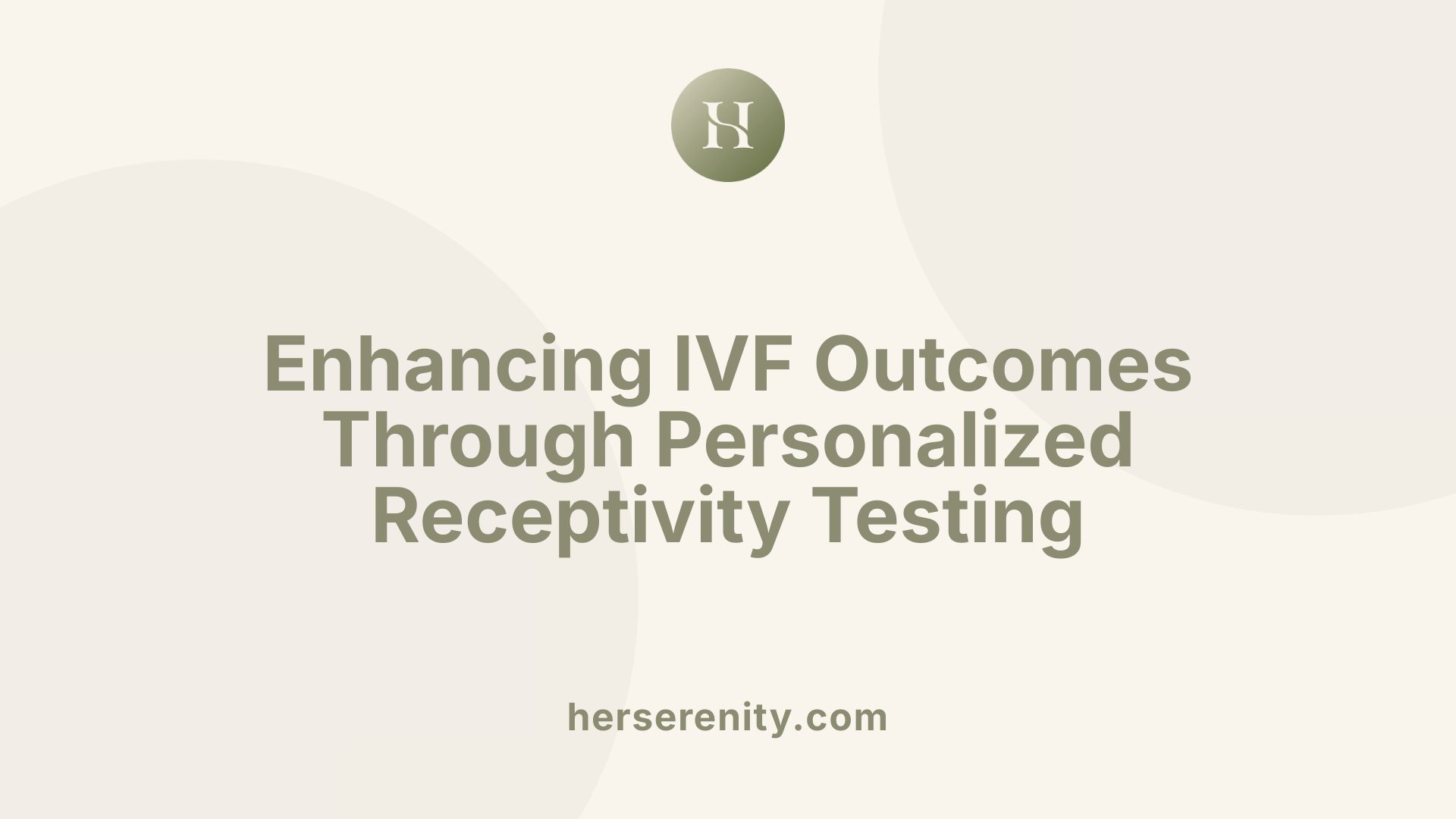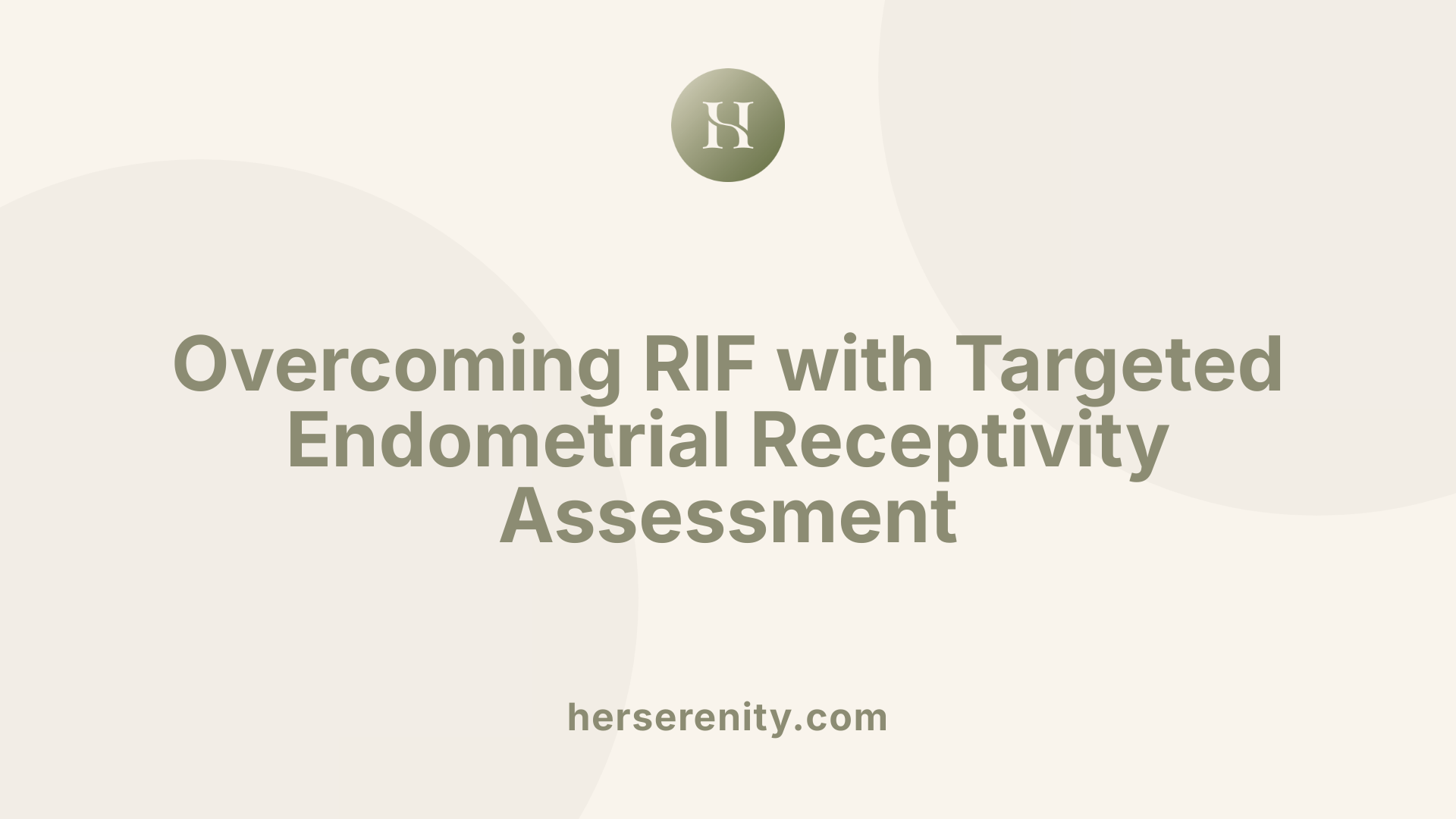Can endometrial receptivity testing improve IVF success?
Evaluating the Role of Endometrial Receptivity Testing in IVF Outcomes

Understanding the Potential of Personalized Embryo Transfer
In the quest to enhance IVF success rates, endometrial receptivity testing has emerged as a promising tool. By assessing the readiness of the uterine lining for embryo implantation, clinicians aim to tailor embryo transfer timing, potentially improving pregnancy outcomes. This article delves into how these tests work, the scientific evidence supporting their use, and their role in addressing recurrent implantation failure.
What is Endometrial Receptivity Testing and Its Mechanism
 Endometrial receptivity testing, exemplified by the Endometrial Receptivity Array (ERA), is a diagnostic tool designed to evaluate whether the uterine lining is prepared for embryo implantation. This test focuses on analyzing gene expression patterns to determine the optimal timing for embryo transfer during IVF.
Endometrial receptivity testing, exemplified by the Endometrial Receptivity Array (ERA), is a diagnostic tool designed to evaluate whether the uterine lining is prepared for embryo implantation. This test focuses on analyzing gene expression patterns to determine the optimal timing for embryo transfer during IVF.
The process begins with a small biopsy of the endometrial tissue, usually performed during a specific period of the menstrual cycle when the endometrium is expected to be receptive. This involves administering hormones to prepare the endometrium, followed by collecting a sample with a catheter. The sample then undergoes molecular analysis, where the expression levels of 238 genes related to endometrial receptivity are assessed.
By examining these gene expression patterns, the test identifies if the endometrium is currently in a receptive state (the typical window of implantation), pre-receptive (not yet ready), or post-receptive (past the optimal period). This analysis helps in pinpointing the individualized 'window of implantation' for each woman.
The primary advantage of this approach is enabling personalized timing for embryo transfer. If the test indicates the endometrium is out of phase, the timing can be adjusted in subsequent cycles. This personalized approach aims to maximize the chances of successful implantation by synchronizing embryo transfer with the peak receptivity of the endometrium.
In summary, endometrial receptivity testing involves a biopsy and molecular gene expression analysis to determine the endometrial state, guiding targeted embryo transfer timing that could potentially improve IVF success rates and address issues related to implantation failure.
Scientific Evidence and Clinical Effectiveness of Receptivity Testing
Research findings on ERA and related tests
The Endometrial Receptivity Array (ERA) utilizes molecular techniques, specifically gene expression analysis, to determine the optimal timing for embryo transfer during IVF. It assesses the activity of 238 genes associated with endometrial receptivity, providing a detailed picture of whether the lining is pre-receptive, receptive, or post-receptive. Numerous studies have investigated the clinical benefits of this approach. Evidence suggests that ERA is especially beneficial for women experiencing recurrent implantation failure (RIF), where multiple embryo transfers have not resulted in pregnancy despite high-quality embryos.
Benefits primarily in recurrent implantation failure (RIF) cases
In patients with a history of RIF, ERA-guided personalized embryo transfer has demonstrated improved outcomes. Several studies, including large retrospective cohorts, report higher clinical pregnancy and live birth rates when embryo transfer timing is adjusted based on ERA results. These findings support the notion that displaced or altered windows of implantation are common in RIF patients and that correcting timing can significantly enhance their chances of success.
Mixed results from large studies and randomized controlled trials
However, not all research is conclusive. Several randomized controlled trials (RCTs) and systematic reviews have produced mixed results. For example, a notable multicenter RCT involving over 700 women with euploid embryos found no significant difference in live birth rates between those guided by ERA and those undergoing standard timing. Similarly, some large cohort studies report no improvement or even potential decreases in success rates using ERA in unselected IVF populations.
Meta-analyses and systematic reviews
Systematic reviews, which analyze multiple studies collectively, generally conclude that ERA does not significantly improve reproductive outcomes in the broader IVF population. These comprehensive analyses emphasize that while ERA may help certain subgroups, especially RIF patients, its routine use in all IVF cases remains unsupported by high-quality evidence. They also point out that factors influencing implantation are multifaceted and that molecular testing alone may not be sufficient to predict success.
Limitations and ongoing debates about efficacy
Despite promising findings in specific groups, debates persist regarding the overall efficacy of ERA. Critics highlight limitations such as variability in methodology, the challenge of precisely defining the window of implantation, and the multifactorial nature of implantation failure. There is ongoing discussion about whether molecular profiling can fully capture the complexity of endometrial receptivity. Further high-quality RCTs are needed to confirm whether widespread application of ERA genuinely improves IVF success rates or if its benefits are confined to particular cases.
Impact on Implantation and Pregnancy Success

How can endometrial receptivity testing influence implantation and pregnancy outcomes?
Endometrial receptivity testing, such as the ERA (Endometrial Receptivity Analysis), aims to personalize the timing of embryo transfer by assessing the precise window when the endometrium is most receptive. This approach helps identify whether the endometrial lining is ready for implantation or if the window is displaced.
Research shows that in patients with previous unsuccessful embryo transfers, ERA-guided personalized embryo transfer can significantly improve pregnancy outcomes. For example, some studies report pregnancy rates as high as 65% with ERA-guided transfers, compared to around 37% in controls. Live birth rates and ongoing pregnancy rates also increase notably in certain groups, particularly those with recurrent implantation failure.
One major advantage of ERA is its ability to detect a displaced window of implantation. By adjusting the timing based on gene expression profiles, clinicians can optimize the likelihood of successful implantation.
However, evidence from multiple studies, including large systematic reviews, presents a mixed picture. While some trials advocate for the benefit of ERA, especially in patients with repeated failures, others conclude that it does not significantly improve outcomes in a broad IVF population. These conflicting results suggest that endometrial receptivity testing may be most beneficial in specific cases rather than as a routine procedure for all patients.
Overall, ERA offers a personalized approach that can enhance understanding of individual endometrial timing, potentially increasing pregnancy and live birth rates when correctly applied. Still, its universal application remains debated, underscoring the importance of continued research and carefully selecting candidates for testing.
Special Focus: Recurrent Implantation Failure and the Role of ERA
 Recurrent implantation failure (RIF) remains one of the most challenging issues in in-vitro fertilization (IVF). Women with RIF frequently experience frustration despite transferring high-quality, chromosomally normal embryos. A significant factor behind RIF is the timing mismatch between embryo development and the uterine endometrial receptivity.
Recurrent implantation failure (RIF) remains one of the most challenging issues in in-vitro fertilization (IVF). Women with RIF frequently experience frustration despite transferring high-quality, chromosomally normal embryos. A significant factor behind RIF is the timing mismatch between embryo development and the uterine endometrial receptivity.
To address this, endometrial receptivity testing, such as the Endometrial Receptivity Array (ERA), has emerged as a valuable diagnostic tool. The ERA assesses the expression of 238 genes involved in preparing the endometrium for implantation, helping to identify if the ‘window of implantation’ (WOI) is displaced or altered in individual patients.
Studies have shown that many women with RIF have a displaced WOI. This means that their endometrium may be out of sync with the typical timing, reducing chances of successful implantation. By pinpointing the precise timing of receptivity, ERA enables personalized embryo transfer (pET), aligning embryo placement with optimal endometrial condition.
Clinical evidence supports the benefits of ERA in RIF cases. For example, a study involving patients with previous failed transfers demonstrated that those guided by ERA had significantly higher clinical pregnancy rates and live birth outcomes. This personalized approach adapts transfer timing, overcoming one of the major barriers to implantation.
Overall, endometrial receptivity testing proves promising for women facing recurrent failures. It helps tailor IVF protocols to individual uterine dynamics, increasing the likelihood of achieving pregnancy. Multiple trials confirm that integrating ERA into treatment strategies benefits women with RIF by improving implantation success rates and, ultimately, reproductive outcomes.
Benefits, Limitations, and Controversies of Receptivity Testing

What are the benefits and limitations of endometrial receptivity testing in IVF?
Endometrial receptivity testing (ERT), such as the ERA, provides the advantage of tailoring embryo transfer timing to a woman's unique endometrial window, known as the window of implantation (WOI). This personalized approach aims to enhance the chances of implantation and pregnancy, particularly in patients who have experienced recurrent implantation failures (RIF) or multiple unsuccessful IVF attempts. By analyzing gene expression patterns within the endometrial tissue, ERA can identify whether the lining is receptive, pre-receptive, or post-receptive, allowing clinicians to optimize transfer timing.
Despite these benefits, the method has significant limitations. Scientific evidence on its overall effectiveness remains mixed. Some studies suggest improvements in pregnancy success for specific groups, yet systematic reviews and large clinical trials often show no substantial benefit in unselected populations or for all patients undergoing embryo transfer. Moreover, the procedure involves invasive biopsies, which may cause discomfort and carries minimal but real risks. The added costs, which can range between ₹30,000 to ₹50,000, and the lack of regulatory approval in some regions also pose barriers. Due to these factors, the routine use of ERA remains controversial.
In conclusion, while ERA offers promising insights and potential advantages for certain patient groups, its limitations and the ongoing debate in the field mean it should be used judiciously. Patients and clinicians must weigh the benefits against the costs and current evidence to make informed decisions. Overall, personalized receptivity testing can be a valuable tool in specific circumstances, but it is not universally necessary for all IVF treatments.
Does Timing Embryo Transfer Based on Receptivity Improve Success?
Numerous studies have investigated whether timing embryo transfer according to endometrial receptivity assessments, like the ERA test, leads to better IVF outcomes. High-quality evidence, especially from randomized controlled trials (RCTs), provides important insights.
One large, multicenter, double-blind RCT involving 978 IVF patients with euploid blastocysts compared personalized embryo transfer (pET) guided by ERA results versus standard timing. The primary outcome was live birth rate. Results showed no significant difference: 58.5% in the ERA-guided group versus 61.9% in the control group, with a P-value of .38. Secondary measures such as biochemical and clinical pregnancy rates also revealed no notable benefits.
Despite this, some retrospective analyses suggest that certain patient groups, particularly those with previous implantation failures, might benefit from personalized timing. For example, studies indicate improved clinical pregnancy and live birth rates after ERA-guided transfer in women who experienced recurrent IVF failure.
However, the overall consensus from current high-quality research does not support routine use of receptivity testing, such as ERA, in all IVF cases. Its benefits seem limited to specific subsets of patients rather than the broader population.
Consequently, while the concept of optimizing transfer timing via molecular assessments is appealing, the existing strongest evidence does not show significant improvements in live birth rates for the general IVF population. Ongoing research continues to evaluate whether certain groups might derive more benefit from this personalized approach.
Current Research, Expert Opinions, and Future Directions
Recent studies and expert reviews reveal a complex landscape regarding the use of endometrial receptivity testing in fertility treatments. These molecular assessments, such as the ERA, analyze gene expression to identify the optimal window for embryo transfer, aiming to tailor procedures for better outcomes.
For women with recurrent implantation failure (RIF) or displaced windows of implantation, evidence suggests targeted benefits. In these groups, personalized embryo transfer guided by ERA can improve pregnancy and live birth rates, with some research indicating nearly 70% success when properly timed. Conversely, large systematic reviews and randomized trials involving broader patient populations often show no significant advantage of routine receptivity testing. For example, some recent studies have concluded that in unselected populations, ERA does not enhance live birth rates and may add unnecessary cost.
The scientific community remains divided. While many clinicians see potential in precision medicine approaches—especially with new technological advancements—others call for caution due to inconsistent results across studies. The variability in findings has prompted ongoing debates about the clinical relevance and cost-effectiveness of widespread usage.
Emerging technologies hold promise for the future. Multi-omics approaches integrating genomics, transcriptomics, proteomics, and metabolomics aim to provide a comprehensive view of endometrial health and receptivity. Single-cell analysis and artificial intelligence are also being explored to refine diagnosis and personalize treatment further.
Despite these advances, there is a consensus on the need for robust evidence. Large, well-designed randomized controlled trials are critical to definitively determine whether these sophisticated tools can reliably improve fertility outcomes. Currently, experts recommend individualized testing mainly for patients with a history of recurrent failures or displaced WOI, emphasizing a cautious and evidence-based approach.
In sum, endometrial receptivity testing shows promise but remains an evolving science. Its routine application in fertility clinics awaits validation from ongoing research, with personalized medicine at the forefront of future fertility care strategies.
Success Stories and Practical Experiences with ERA
Are there success stories related to the use of the ERA test in IVF?
Yes, many women and couples have experienced successful pregnancies after using ERA testing to guide their embryo transfers. For instance, a 32-year-old woman facing repeated IVF failures was able to conceive and deliver a healthy baby following ERa-guided embryo transfer. This case highlights how identifying the correct window of implantation can significantly improve chances of success.
Patients like Samantha and Matthew also found success with ERA testing. After several unsuccessful embryo transfers, they used the results from ERA to time their embryo transfer precisely during the optimal receptivity window, leading to pregnancy and eventual healthy delivery.
Scientific research supports these individual stories. A notable randomized controlled trial involving 458 women under 38 years of age shown that personalized embryo transfer based on ERA results increased the live birth rate compared to standard timing methods. Although results across studies are mixed, many suggest that ERA can be particularly beneficial for women with previous IVF failures.
Overall, these real-life examples and clinical evidence demonstrate that ERA can be a valuable tool, especially for those struggling to achieve pregnancy despite good-quality embryos. It offers hope and a tailored approach to enhancing IVF success rates.
Balancing Promise with Evidence in Fertility Treatments
While endometrial receptivity testing, notably ERA, offers a personalized approach that can optimize embryo transfer timing, the current body of evidence presents a mixed picture. Its benefits appear most clear in specific patient groups, especially those facing recurrent implantation failure. Nonetheless, larger, high-quality randomized trials are needed to definitively establish its routine utility. Clinicians and patients should weigh the potential advantages against costs, invasiveness, and the ongoing debates about clinical effectiveness. As research advances and new technologies emerge, the role of receptivity testing in IVF will continue to evolve, promising a future of more tailored and potentially successful fertility treatments.
References
- Review of Endometrial Receptivity Array: A Personalized Approach ...
- Does endometrial receptivity array improve reproductive outcomes ...
- What is the ERA Test Success Rate and Can it Help Me Conceive?
- The study on the clinical efficacy of endometrial receptivity analysis ...
- A New ERA: Can Endometrial Receptivity Analysis Increase My ...
- Effect of Timing by Endometrial Receptivity Testing vs Standard ...
- Frozen embryo transfer: evidence-based markers for successful ...
- Clinical outcomes following endometrial receptivity assessment ...
- ERA Test May Increase Pregnancy Success in Frozen Embryo ...
- Endometrial Receptivity Test | Improve IVF Success Rates



































































































